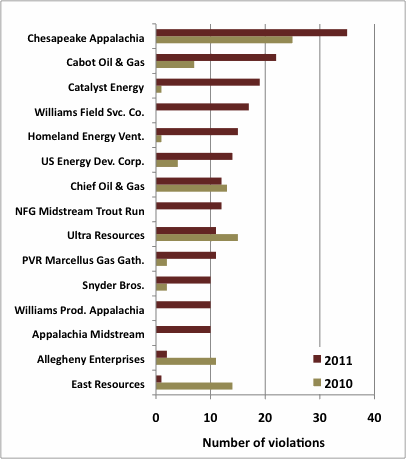Pennsylvania Oil & Gas Enforcement - Violations
Drilling and Violations

Click chart for larger version
Between 2005 and 2011 more than 24,000 oil and gas wells were drilled in Pennsylvania. During that time, there were more than 15,000 violations. Interestingly, since 2008 the number of wells drilled per year has decreased, yet the number of violations per year has more than doubled – from 1,500 in 2008 to 4,069 in 2011.[1]
One of the possible reasons for the recent increase in violations is that there has been an increase in inspections. The following chart, which uses data from DEP’s Oil and Gas Compliance Report system, shows a fairly strong relationship between oil and gas violations and the number of inspections in Pennsylvania. In 2009, inspectors found considerably more violations than other years, and 2005 was a low year for violations. Otherwise, it appears that more inspections result in more violations being found.
Violations and Inspections

Click chart for larger version
The chart also shows that the number of oil and gas rule violations found by Pennsylvania oil and gas inspectors spiked in 2009 and has remained high ever since; 2011 had the most violations of any year in the past decade.
Violations - bad actors abound
Despite an increase in inspections, violations data suggests that the practices of many operators are getting worse, not better, with time. Table 1 shows the twelve operators with the most violations in 2011. All but two (Chief and Anadarko) had more violations in 2011 than in previous years, and many operators have had consistently large numbers of violations for three years running (e.g., Chesapeake, Cabot, Chief, Range, XTO, Ultra).
It should be noted that the operators with the most violations are not necessarily those with the largest number of wells. There are 23 operators in Pennsylvania with more than 1,000 active wells, yet only five of them appear in the following table.
Trends in violations for the top offenders in Pennsylvania

Click chart for larger, footnoted version

Click chart for larger, footnoted version
DEP data also show that many operators repeatedly violate the same rule at different well sites, and from one year to the next.[2] This chart shows the companies that most frequently violated Rule 102.4, which governs erosion and sediment control requirements, in 2010 and 2011. As seen in this chart, Chesapeake had the worst record, with 25 violations of rule 102.4 in 2010, and 35 violations of the rule in 2011. In addition, Cabot, Chief, and Ultra Resources had numerous violations of this rule in 2010 and again in 2011.
The increase in violations in 2011, the pattern of non-compliance among some operators, and the fact that operators violate some rules time-and–time-again makes it clear that DEP’s inspection enforcement actions are not deterring operators from repeatedly breaking the rules and polluting the environment in Pennsylvania.
For more information:
- Earthworks: Enforcement Report - DEP: Public should not have confidence that oil and gas development is occurring responsibly in the state of Pennsylvania. Report
- Earthworks: Pennsylvania Oil & Gas Enforcement - Inspections. Web page
- Earthworks: Pennsylvania Oil & Gas Enforcement - Violations. Web page
- Earthworks: Pennsylvania Oil & Gas Enforcement - Enforcement Actions. Web page
- Earthworks: Pennsylvania Oil & Gas Enforcement - Public Participation. Web page
Endnotes
1 As seen in this table, violations per year more than doubled from 1,515 in 2008 to 4,069 in 2011 (and they've more than quadrupled since 2005). Meanwhile, wells drilled decreased from 4,249 in 2008 to 2,944 in 2011.
Pennsylvania drilling and violations data

Click chart for larger, footnoted version
2 Using data downloaded from the Pennsylvania DEP Compliance Reporting system, it was possible to sort the data by “Violation Code” to determine which companies frequently violated a particular rule. View data chart.
Tagged with: violations, regulations, pennsylvania department of environmental protection, pennsylvania, fracking, enforcement, drilling
Follow Earthworks